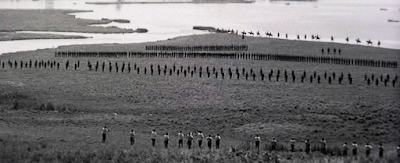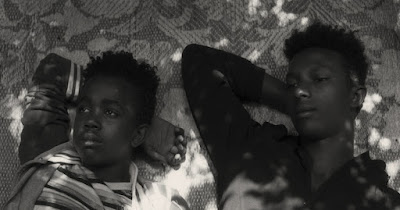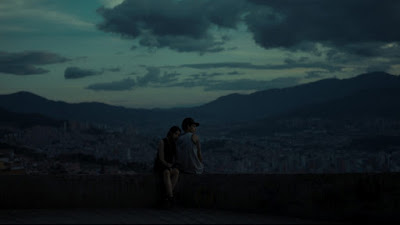My past Movie World Cups were about finding films from the different countries taking part in the Soccer World Cup. The films themselves weren’t about soccer. This time around for the 2022 World Cup, I have decided to compile a list about the best soccer/fútbol films I have seen. And like a soccer team formation, the films can be arranged in a starting 11 with each film occupying a different soccer position. As it turns out, the 11 films cover different aspects of the game and feature some of the best players to have played the game along with the struggles of a manager, the challenges that referees face and problems of being a fan. The films also cover other topics as children who dream of being progressional soccer players, fans with radical ideas to improve the game, manipulative family members who double as soccer agents and a ‘friendly’ soccer game between enemies. A complete football circle of life! That means, Diego Maradona, Pele, Messi, Zidane are present in the films. While Cristiano Ronaldo isn’t there, his look-alike is. Barcelona are there as are Real Madrid, Arsenal, Man United, Leeds United and many other national and club teams in snippets.
My favourite Soccer Films starting 11 line-up in preferential order:
1. Diego Maradona (2019, UK, Asif Kapadia)
This brilliant film came out just a year before Maradona’s tragic death in 2020 and forms a timely and perfect tribute to the greatest soccer player of all time (sorry, Pele, Messi but I have to tip the hat to Diego).
2. Zidane: A 21st Century Portrait (2006, France/Iceland, Douglas Gordon/Philippe Parreno)
This Belgium soccer documentary does not have any narration or title cards to guide the audience but instead dives right into the action. Like the Zidane film, this documentary gives a completely different perspective to what one experiences when watching a soccer game. One gets to see the game from an on-field angle, but instead of a player's point of view, we see the game from a referee's angle.
This film is essential viewing for anyone who has ever seen a soccer game. And since the film is artistically shot and edited, it offers non-soccer fans plenty to chew on as well. The games shown in the film are from Euro 2008 and if a person is familiar with some of the players, then that enhances the experience. This film does an excellent job in showing us the human side of the refs and also some of the egos that operate in the game.
4. Bend it Like Beckham (2002, UK/Germany/USA, Gurinder Chadha)
This lovely film nicely layers its coming-of-age, cultural clash, female perspective elements around its soccer core.
5. The Damned United (2009, UK/USA, Tom Hooper)
6. Fever Pitch (1997, UK, David Evans)
An essential soccer film based on Nick Hornby’s wonderful book about an Arsenal fan. Even though the film is centered around Hornby’s Arsenal obsession, most soccer fans (not only Arsenal fans) would probably fall into the categories shown in the film – optimistic and always pessimistic. The optimistic ones always believe their team will win, no matter who the opposition. And the pessimistic believe that their team is capable of always screwing up even when their opposition is a non-league team.
This movie shows what it means to be a soccer fan and serves to highlight the difficulties men have in trying to make women understand what this game means. Plenty of soccer relevance in this film as the film shows school football, a frustrated coach, soccer vs women debates, amateur & professional football and the crazy life of a soccer fan. Also, the movie covers the dangers of all standing sections in English stadiums in the past, something which may have added to the flavour of the game in the old days but also led to some grave consequences (racism, abuse, death and fights).
7. Take the Ball, Pass the Ball (2018, Spain, Duncan McMath)
Based on Graham Hunter’s book, Barça: The Making of the Greatest Team in the World, Take the Ball Pass the Ball looks at Barcelona’s team between 2008-12 when the arrival of Pep Guardiola transformed the way Barcelona played and revolutionized the overall game. The film is an ode to the beauty of the game. The football that was played by that Barcelona team between 2008-12 was some of the best the world has ever seen. Given how sterile the game has become now, it is incredible to think it wasn’t long ago that Guardiola’s Barcelona team produced many jaw-dropping moments. Perhaps, sometime in the future, another team will produce such football again. Until then, there are the highlights and this film.
8. The Goalie's Anxiety at the Penalty Kick (1972, West Germany/Austria, Wim Wenders)
Goalkeepers have often been considered eccentric lonely characters mostly due to their role where they are isolated for long periods of the time from the rest of the outfield players. Things are changing now with goalies being brought into the game a lot more but that wasn’t the case back in 1972. While the film isn’t about soccer, it does feature elements that are part of the game even today: the stress and tension both goalies and a penalty taker faces when each tries to beat the other.
9. Victory (1981, UK/USA, Italy, John Huston)
It is still hard to believe that this movie exists and features the people it does. Real life soccer legends Pele, Bobby Moore and Osvaldo Ardiles are in the film as are Sylvester Stallone, Michael Caine, Max Von Sydow!
The story revolves around a ‘friendly’ soccer game between the German National team and a team of captured British Allied Prisoners of War in 1942. Max Von Sydow (who plays a German General, Karl Von Steiner) spots Colby (Caine) teaching soccer for the captured prisoners. Since Steiner was a former soccer player for the German National team, he recognizes Colby as a former professional player (Colby played for West Ham and England). He proposes a soccer game between Colby’s students and a collection of German soldiers/captains. After negotiating for extra food rations and better sports equipment, Colby agrees. When news of the games reaches the German high administration, they decide to use the game as a means of propaganda. The stakes are raised with the German National team playing not just against Colby’s boys but an allied World team of British colonies. The game would be held in Paris. The British hate the idea of the game, and decide to hatch a plan to let the entire team escape – they feel this is the only way they can make the Germans look bad.
What is interesting about this movie is that real soccer players were used, with the exception of Caine and Stallone. The soccer game footage is shot very well and the match is quite interesting.
10. Infinite Football (2018, Romania, Corneliu Porumboiu)
This documentary features Laurentiu Ginghina who has creative ways to reinterpret the game. Perhaps, somebody can get Ginghina to spend a few hours with Marcelo Bielsa, Pep Guardiola and Jürgen Klopp.
11. Diamantino (2018, Portugal/France/Brazil, Gabriel Abrantes/Daniel Schmidt)
In the film, the World’s greatest soccer player Diamantino (clearly modelled on Cristiano Ronaldo) undergoes a major existential crisis on the eve of the World Cup final after he comes across a group of refugees. He wants to quit the game and give away his money much to the dismay of his evil twin sisters who have big plans for him including working with a far-right political party that wants to clone Diamantino and use his image to force Portugal to leave the EU.
This doesn’t even cover half of the events in the film which is packed with delirious characters including sinister villains and undercover agents while also including visions of gigantic cute puppies. There hasn’t and will never be a film like Diamantino, a mind-altering innovative film that smartly incorporates current burning political topics and multiple film genres including fantasy, satire, science-fiction and romance.
Formation for 11 movies
If all the films had to be arranged in a soccer formation, the formation that naturally appears to form is 3-4-1-2 or 3-4-3.
1. Goalkeeper: the film The Goalie's Anxiety at the Penalty Kick takes the spot.
2. Defence: Fever Pitch, Victory, The Damned United
The first spot goes to Fever Pitch which is about George Graham’s defensive Arsenal team of 1989. Victory and The Damned United take the next spots due to their tough-tackling nature although Victory does feature Pele, one of the three best players to have ever played the game (the best of all time for many).
3. Midfield: Take the Ball, Pass the Ball, Bend it Like Beckham, Infinite Football, The Referees
Take the Ball easily takes one of the spots due to midfield duo of Xavi-Iniesta. Bend it like Beckham takes another spot due to Beckham’s ability to swing in crosses from the wings. Infinite Football is about creative ideas and midfield is about all creativity where those ideas would be most useful. The Referees is essentially about people outside of a team's formation but since all games start in the middle, this film takes the final midfield spot.
4. Attack: Diego Maradona, Diamantino, Zidane
Diego and Diamantino (also Cristiano Ronaldo) take the front two spots with Zidane operating slightly behind them. In that sense, Zidane can pay behind the two attackers or move up in attack to form an unstoppable front three.
Offside (2006, Iran, Jafar Panahi)
Fans are an essential part of the game and their presence in the stadium elevates a game’s atmosphere. This vital film from one of cinema’s master directors is about female fans not being able to get into the stadium to see a game due to national and cultural restrictions.
Forza Bastia (1978, France, Jacques Tati/Sophie Tatischeff)
Jacques Tati's last directed work was a football film, a 26 minute documentary, that he directed in 1978. However, the film only surfaced in 2001 thanks to his daughter Sophie Tatischeff. The film was shown at the Kicking + Screening Soccer Film Festival in Amsterdam 2011.
It is a remarkable film that shows the excitement in Bastia leading up to their first leg of the 1978 UEFA Cup final against PSV Eindhoven. Tati's focus is on the dedicated and loyal fans, showing their pre-game rituals along with their tension and anxiety during the game. There are some amazing sounds captured of the game itself which was played out on a water logged pitch and ended 0-0. Overall, this film is a great treasure not only of football's history but of cinema itself.
For the record, PSV won the second leg 3-0 to win the 1978 UEFA Cup.
Rudo y Cursi (2009, Mexico/USA, Carlos Cuarón)
Rudo y Cursi may feel like a Hollywood film in its treatment but the film redeems itself in the penalty shot near the end where the ironic fates of soccer and life in general are respected. The ending can only be written by someone who understands that, in soccer, games can end just as they start.
An over the top black and white film that captures the eccentric nature of soccer along with that of a corrupted referee (which according to fans still haunts the game today).
The film introduces a fictional element in depicting West Germany’s first World Cup triumph in the 1954 World Cup.
Mean Machine (2001, UK/USA, Barry Skolnick)
Gregory's girl (1981, UK, Bill Forsyth)
My Name is Joe (1998, UK/Germany/France/Spain, Ken Loach)
The Acid House (1998, UK, Paul McGuigan)
Three different shorts which tackle themes of revenge, violence vs non-violence and pure drunken stupor! All the main characters in the three shorts could have been following the same game (the semi-finals of the Scottish Cup) and yet each go about their life differently. Not all soccer fans are drunken hooligans or immature adults as the media shows. Some of them are, but the rest are average blokes just trying to watch a game.
Historias de fútbol / Football Stories (1997, Chile, Andrés Wood)
The film is divided into three short stories titled First half, Second Half and Overtime. All three segments demonstrate love of football with the “First half” showing the professional game and issues such as bribing and betting. The “Second half” presents a pure love for the game that can only be found at the youth level. “Overtime” looks at the obsessive addiction to the game that men develop. Yet, “Overtime” is also the most mature segment and shows that lust for a woman can make a man forget about the game. Soccer may be an obsession and sole focus for a single man but as a man grows up and discovers other loves, soccer is integrated into their daily lives along with their job and relationships and is no longer their only focus. Well in theory at least.
A normal soccer match goes down in skill as the game goes into overtime because the tiring legs prevent too many genuine creative chances. However, Football Stories is strongest in the "Overtime" segment and is weakest in the "Second half.”
Goal! The Dream Begins (2005, UK/USA, Danny Cannon/Michael Winterbottom)
A rags to riches story about a Mexican kid who moves from LA to play for Newcastle United. Given the recent influx of cash in Newcastle, perhaps this movie may end up being a precursor to real life. Even though the film contains many clichéd elements, it has a good heart and a few worthy scenarios such as having a soccer manager clearly modelled after Arsène Wenger.
The Worker’s Cup (2017, Qatar/UK, Adam Sobel)
The topic is entirely appropriate given the setting of Qatar as the 2022 World Cup host. The documentary features the workers who helped build the stadiums that will host the games.
Das Spiel (2020, Switzerland, Roman Hodel)
Worthy short film (17 minutes) from the perspective of a referee in charge of an intense soccer game.
Messi (2014, Spain, Álex de la Iglesia)
Cup Final (1991, Israel, Eran Riklis)
Green Street Hooligans (2005, UK/USA, Lexi Alexander)
Heleno (2011, Brazil, José Henrique Fonseca)
Looking for Eric (2009, UK/France, Italy/Belgium/Spain, Ken Loach)
FC Venus (2005, Finland, Joona Tena)
Children (2006, Iceland, Ragnar Bragason)
Eleven Men Out (2005, Iceland, Róbert I. Douglas)
Kick 'N Rush (2003, Denmark, Aage Rais-Nordentoft)






































